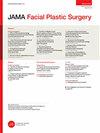Functional Outcomes, Quantitative Morphometry, and Aesthetic Analysis of Articulated Alar Rim Grafts in Septorhinoplasty.
Q1 Medicine
引用次数: 9
Abstract
Importance The design, use, and indications for the articulated alar rim graft (AARG) and the functional and aesthetic improvements that can be achieved have not been fully characterized. Objective To analyze the functional and aesthetic outcomes of AARG placement on nasal airway function, nasal base shape change, and appearance. Design, Setting, and Participants A case series study of patients who underwent septorhinoplasty with placement of AARG at University of California, Irvine Medical Center, from 2015 to 2018 was carried out. Surgical data recorded included stage of rhinoplasty (primary vs revision), use of spreader grafts, rim grafts (and dimensions), caudal septal extension graft (CSEG), lateral crural tensioning (LCT), and turbinate reductions. Main Outcomes and Measures Preoperative and postoperative Nasal Obstruction Symptom Evaluation Survey (NOSE) surveys were analyzed and correlated with AARG geometry, use of CSEG, and the LCT maneuver. Preoperative and postoperative alar base views were evaluated by fitting base shape to a parametric numerical model to categorize each to 1 of 6 shape categories. Blinded reviewers rated alar furrow severity and the alar ridge presence using a Likert scale for both preoperative and postoperative images to subjectively gauge aesthetic outcomes. Results Overall, 90 patients with both preoperative and postoperative NOSE scores who underwent septorhinoplasty and placement of an AARG were included. Of the 90 patients, 60 were women (mean age, 38.2 years). Patient NOSE scores (70.4 preoperatively to 25.1 postoperatively) significantly improved from preoperation to postoperation (P < .001), regardless of AARG size, CSEG, or LCT. Alar base shape parametric analysis showed preoperative to postoperative improvements were significant for anterior-to-posterior ratio mass distribution (95% CI, -0.16 to 0.02; P = .05) and vertical projection-to-horizontal base width ratio (95% CI, 0.01-0.32; P = .02) in flat noses and cloverleafing for narrow noses (95% CI, -0.05 to -0.01; P = .001); enhancement approached significance for reduction in lateral scalloping in cloverleaf noses (P = .06). Aesthetic analysis showed that there was a statistically significant improvement for the alar furrow (95% CI, -0.68 to -0.29 for rater 1; -0.54 to -0.27 for rater 2; and -0.59 to -0.27 for rater 3; P < .001) for all raters and for the alar ridge (95% CI, 0.16-0.48; P < .001) for 1 rater. Conclusions and Relevance To our knowledge, this is the first study to demonstrate that AARG use is associated with statistically significant improvement in NOSE scores. Placement of AARGs may improve posterior mass ratios in flat noses and lateral cloverleafing in narrow noses as suggested by quantitative shape change parameter analysis. The placement of AARGs was associated with aesthetic and functional enhancement in the cloverleaf deformity, which is associated with a prominent alar furrow, and often external nasal valve collapse. Patient selection is key when placing AARGs. Level of Evidence NA.鼻中隔成形术中关节鼻翼缘移植物的功能结果、定量形态学和美学分析。
铰接式鼻翼缘移植物(AARG)的设计、使用和适应症以及可以实现的功能和美学改进尚未得到充分的描述。目的分析AARG置入术对鼻气道功能、鼻基形态改变及外观的影响。设计、环境和参与者对2015年至2018年在加州大学欧文分校医学中心接受鼻中隔成形术植入AARG的患者进行了一项病例系列研究。记录的手术数据包括鼻成形术的分期(初次与翻修)、使用扩张移植物、边缘移植物(和尺寸)、尾间隔延伸移植物(CSEG)、外侧脚张紧(LCT)和鼻甲复位。对手术前后鼻塞症状评价调查(NOSE)调查结果进行分析,并与AARG的几何形状、CSEG的使用和LCT操作相关。术前和术后鼻翼基底视图通过将基底形状拟合到参数化数值模型进行评估,以对6种形状类别中的1种进行分类。盲法评估者使用李克特量表对术前和术后图像进行鼻翼沟严重程度和鼻翼脊存在程度评分,以主观评估美学结果。结果共纳入90例术前和术后鼻中隔成形术和放置AARG的患者。90例患者中,60例为女性(平均年龄38.2岁)。无论AARG大小、CSEG或LCT如何,患者的NOSE评分(术前70.4至术后25.1)从术前到术后显著提高(P < 0.001)。鼻翼基底形状参数分析显示,术前和术后前后比质量分布的改善是显著的(95% CI, -0.16至0.02;P = 0.05)和垂直投影与水平基底宽度比(95% CI, 0.01-0.32;P = 0.02),窄鼻为三叶草型(95% CI, -0.05 ~ -0.01;p = .001);增强对三叶草鼻侧扇贝减少的影响接近显著性(P = 0.06)。美学分析显示鼻翼沟有统计学意义上的改善(95% CI, -0.68至-0.29,评分1;-0.54至-0.27等级2;等级3从-0.59到-0.27;P < 0.001),所有评分者和鼻翼脊(95% CI, 0.16-0.48;P < 0.001)。结论和相关性据我们所知,这是第一个证明使用AARG与NOSE评分的统计学显著改善相关的研究。定量形状变化参数分析表明,放置AARGs可改善扁鼻和窄鼻侧三叶草的后部质量比。在三叶草畸形中,AARGs的放置与美学和功能增强有关,三叶草畸形与突出的鼻翼沟有关,通常是鼻外瓣塌陷。患者选择是放置aarg的关键。证据水平。
本文章由计算机程序翻译,如有差异,请以英文原文为准。
求助全文
约1分钟内获得全文
求助全文
来源期刊

JAMA facial plastic surgery
SURGERY-
CiteScore
4.10
自引率
0.00%
发文量
0
期刊介绍:
Facial Plastic Surgery & Aesthetic Medicine (Formerly, JAMA Facial Plastic Surgery) is a multispecialty journal with a key mission to provide physicians and providers with the most accurate and innovative information in the discipline of facial plastic (reconstructive and cosmetic) interventions.
 求助内容:
求助内容: 应助结果提醒方式:
应助结果提醒方式:


